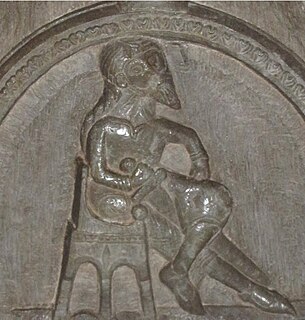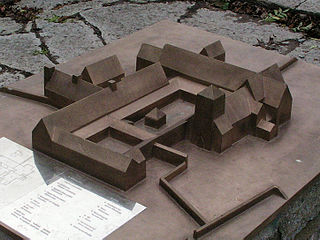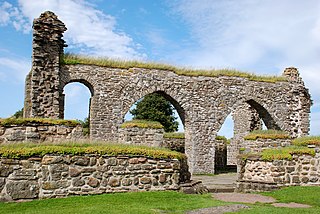Related Research Articles

Sverker I or Sverker the Elder, murdered 25 December 1156, was King of Sweden from about 1132 till his death. Of non-royal descent, he founded the House of Sverker, the rulers of which alternated with the rival House of Eric over the next century.
Inge the Elder was a king of Sweden. In English literature he has also been called Ingold. While scant sources do not allow us to paint a full picture of his term of kingship, he is known to have led a turbulent but at length successful reign of more than two decades. He stands out as a devout Christian who founded the first abbey in Sweden and acted harshly against pagan practices. The kingdom was still an unstable realm based on alliances of noblemen, and Inge's main power base was in Västergötland and Östergötland; one of the earliest chronicles that mention his reign knows him as rex gautorum, king of the Geats.
Magnus Minniskiöld was a medieval Swedish magnate from the House of Bjelbo. For posterity, he is best known as the father of the renowned statesman Birger Jarl, and the ancestor of the later Swedish kings. He is sometimes believed to have perished in the Battle of Lena in 1208, though the evidence is not conclusive.

The Abbey Pax Mariae, more commonly referred to as Vadstena Abbey, situated on Lake Vättern in the Diocese of Linköping, Sweden, was the motherhouse of the Bridgettine Order. The abbey started on one of the farms donated to it by the king, but the town of Vadstena grew up around it. It was active from 1346 until 1595.

Ingeborg of Norway, was a Norwegian princess and by marriage a Swedish royal duchess with a position in the regency governments in Norway (1319–27) and Sweden (1319–26) during the minority of her son, King Magnus of Norway and Sweden. In 1318–1319, she was Sweden's de facto ruler, and from 1319 until 1326, she was Sweden's first de jure female regent.
Svantepolk Knutsson was a Swedish knight and councilor. He became a wealthy feudal lord in Östergötland.
Ulvhild Håkansdotter, , was twice Queen of Sweden and once Queen of Denmark through her successive marriages to Inge II of Sweden, Niels of Denmark, and Sverker I of Sweden. Ulvhild had an important role in the Nordic dynastic connections of her time, but the sources are insufficient on detailed circumstances. She is mentioned as a femme fatale of medieval Scandinavia, as well as a benefactor of the Catholic Church.
Helena or Elin, possibly also known as Maer, Mär or Mö, was Queen of Sweden as the wife of King Inge the Elder, and a supposed sister of King Blot-Sweyn of Sweden.

Helen of Sweden was a Swedish princess and daughter of King Sverker II of Sweden. She was the mother of Queen Catherine of Sweden. She was later Abbess of Vreta Abbey.
The three abductions of maidens from the Vreta convent was a series of events that took place in Sweden in the 13th century. They became legendary and inspired many poems.

Anna Rheinholdsdotter Leuhusen, was the Abbess of St. Clare's Priory in Stockholm. She became known for her involvement in the Swedish War of Liberation between Sweden and Denmark in the 1520s.

Vreta Abbey, in operation from the beginning of the 12th century to 1582, was the first nunnery in Sweden, initially Benedictine and later Cistercian, and one of the oldest in Scandinavia. It was located in the present-day municipality of Linköping in Östergötland.
Ebba Eriksdotter Vasa was a Swedish noblewoman. She was the mother of Queen Margaret Leijonhufvud and the second cousin and mother-in-law of King Gustav Vasa.

Gudhem Abbey is the ruin of a nunnery which was in operation from 1152 to 1529. It is located in Gudhem outside Falköping in the Falbygden area in Västergötland, Sweden. It was initially part of the Benedictine and later Cistercian order. It is considered to have been one of the oldest convents in Sweden; after Vreta Abbey (1100) and Alvastra Abbey (1143).
Benedicta of Bjelbo was a Swedish noblewoman and a central figure in the incident known as the Maiden Abduction from Vreta, wherein she, like her mother, Princess Helen of Sweden before her, and her daughter, Ingrid Svantepolksdotter after her, was abducted from Vreta Abbey by the man she later married. Her abduction was the subject of the folksong "Bridal Abduction of Young Lars" .
Gerdeka Hartlevsdotter, or Hartlefsdotter, also called Gerdica (1370–1438), was a Swedish Bridgettine nun. She was the abbess of Vadstena Abbey from 1403 until 1422.

Skänninge Abbey, also known as St. Ingrid's Priory, St. Martin's Priory or Skänninge Nunnery, was a Roman Catholic convent for females of the Dominican Order in Skänninge in Sweden, in operation from 1272 until 1544. It was founded by Saint Ingrid of Skänninge, and the center of her cult, and as such, it was often referred to as St. Ingrid's Priory. Located near the church dedicated to Martin of Tours, it was originally named St. Martin's Priory, though this name was rarely used in practice. The common name for it was Skänninge Abbey, but as there was also a convent for male members of the Dominican Order in Skänninge, it was often called Skänninge Nunnery to separate it from the male monastery.
Catherine of Sweden was a Swedish princess who married the Danish prince Bjørn Haraldsen Ironside.

Askeby Abbey was a Cistercian nunnery in operation from the late 12th century until 1529. It was located in Askeby outside Linköping, Sweden.
References
- Agneta Conradi Mattsson: Riseberga kloster, Birger Brosa & Filipssönerna, Vetenskapliga skrifter utgivna av Örebro läns museum 2, 1998, ISBN 91-85642-24-X
- Dick Harrison: Jarlens sekel - En berättelse om 1200-talets Sverige, Ordfront, Stockholm, 2002, ISBN 91-7324-999-8
- Kristin Parikh: Kvinnoklostren på Östgötaslätten under medeltiden. Asketiskt ideal - politisk realitet, Lund University Press, Lund, 1991
- "Vreta kloster: Klosterpersonalen - Wikisource". sv.wikisource.org. Retrieved 2014-01-31.